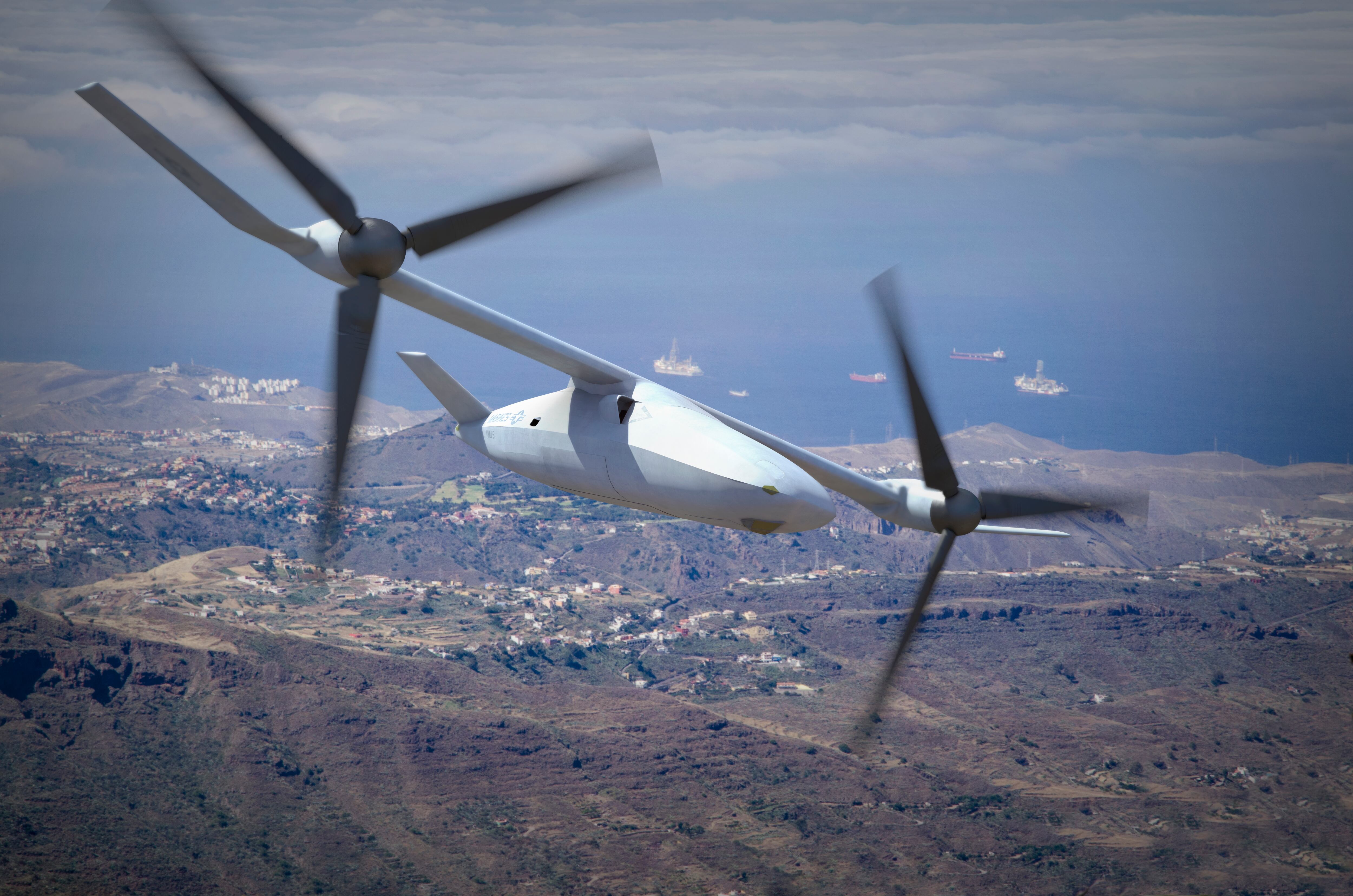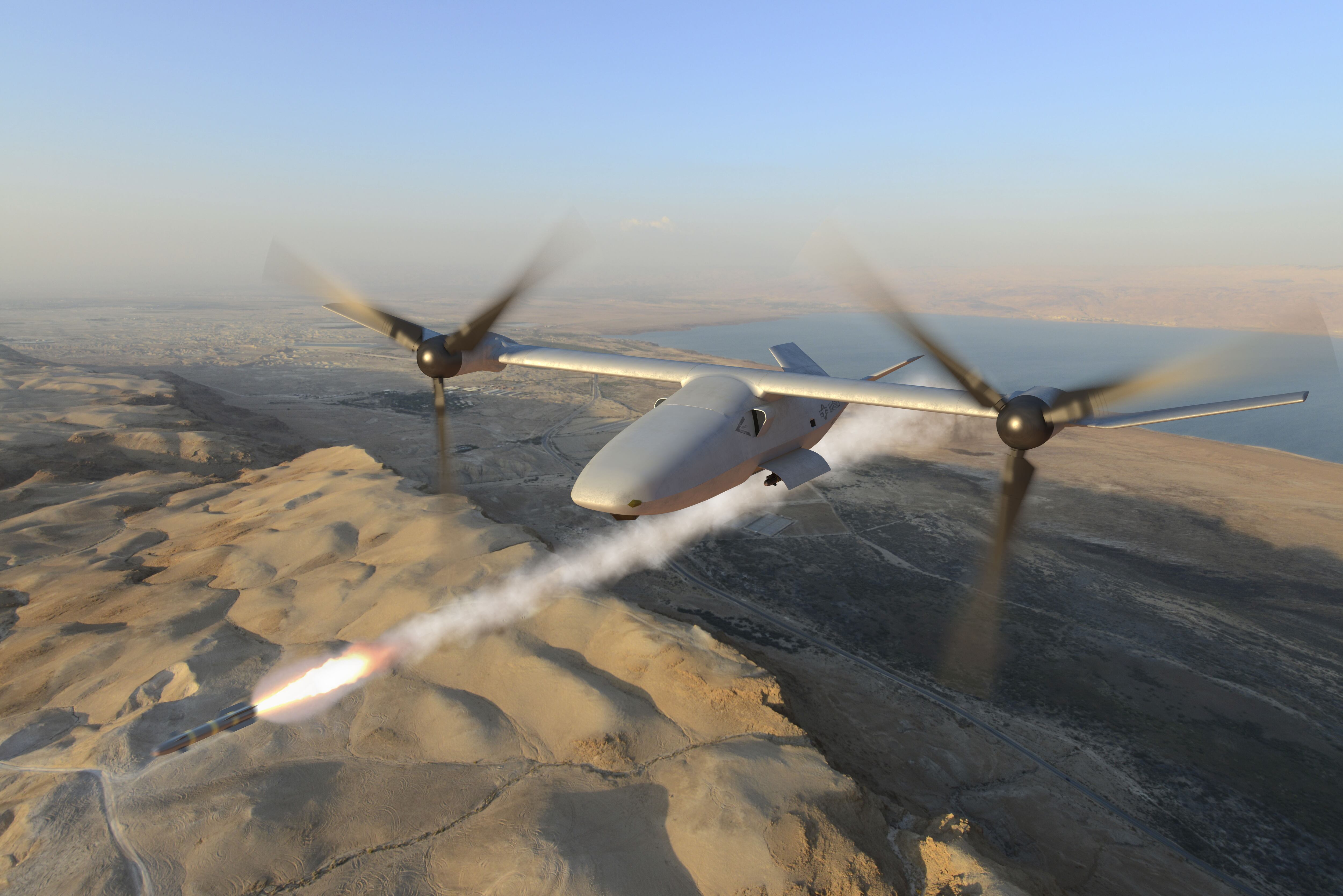The U.S. Marine Corps is developing a tilt-rotor unmanned aerial system that can operate from ships and forward bases. Its tilt-rotor design offers the capabilities of its V-22 Osprey transports — the ability to take off and land vertically in small areas while having the range and speed of a fixed-wing aircraft. The aircraft also complements the service’s future aviation plans.
Developed by Bell Helicopter, the V-247 Vigilant fits into the Marine Corps’ Future Vertical Lift concept, which is an effort to develop a new generation of aircraft to meet the service’s operational needs.
While military jet aircraft have gone through multiple generations of development since their introduction at the end of World War II — Lockheed Martin’s F-35 Lightning II that the Marines and other services are beginning to receive is a fifth-generation jet fighter — U.S. military helicopters are barely out of their second generation. Only the tilt-rotor V-22 Osprey represents a true third-generation vertical lift aircraft, said Col. John Barranco, head of the Aviation Programs and Weapons Requirements Branch at Marine Corps Headquarters.

The latest variants of Marine Corps helicopters such as the UH-60 Blackhawk, while much upgraded and modified, were originally designed in the late 1960s and early 1970s, Barranco explains. Years of counter insurgency combat in Iraq and Afghanistan have demonstrated the need for new vertical lift platforms. “There was a recognition that we simply have not put the time, money, investment and focus into getting our vertical lift technology even remotely caught up to where we are with fixed-wing [aircraft],” he said.
Future Vertical Lift is developing fourth-generation platforms in an integrated family of systems and concepts, Barranco explained. There are five capability sets:
Capability set 1 is a light scout aircraft, while capability set 2 represents a platform somewhere between the OH-58 Kiowa and MH-60 light and medium helicopters. The Marine Corps is focusing on capability set 3, which is a medium lift capability comparable to current UH-1 and MH-60 transport helicopters. Barranco notes that the Marine Corps is working in partnership with the Army and Special Operations Command to jointly develop this platform. Capability set 4 is a heavy lift aircraft similar to the MH-47 or V-22 Osprey, while capability set 5 will be a very heavy vertical lift transport.
Initial planning for what would become the Future Vertical Lift concept began as early as 2013, but the effort formally took shape in late 2016, Barranco said. He adds that the Corps is currently conducting an analysis of alternatives for different platforms in the capability sets, scheduled to be completed in the spring of 2018.
The Bell V-247 Vigilant fits into the light reconnaissance capability set. Its design owes much to the larger Bell V-280 Valor, a tilt-rotor aircraft the Marines are considering for the mid-size platform in capability set 3. One gap that the V-247 could fill is as an escort for V-22 Ospreys, as the tilt-rotor craft are too fast in aircraft mode to be escorted by UH-1 helicopters. This falls into capability gap 3, where the Marine Corps has a large amount of overlap and operational interest from the Army and SOCOM, he said.
While Future Vertical Lift is envisioned as a family of manned platforms, the Marine Corps is very interested in an “optionally manned” capability. The V-247 has the design option to be either a UAS or a manned scout aircraft. This provides the service with operational flexibility and a replacement for the UH-1. Barranco notes that the Marine Corps is interested in an armed utility aircraft version that can be crewed, either with an optional mission kit or a different fuselage.

Another big gap in the service’s operational capabilities is supporting its Marine Air Ground Task Force expeditionary operations. The platform the Marine Corps wants would fall somewhere between capability sets 2 and 3, with the V-247 a definite competitor in this category, Barranco said. This is because the UAS design leverages that of the V-280 and all the research and development funds and expertise put into that platform, he explained. All this advanced research means that the V-247’s technology readiness level is much higher than comparable “clean sheet” UAS designs presented by other aerospace manufacturers.
Much of the V-247’s design and underlying mechanics is derived from the larger V-280. Instead of individual engine pods tilting like the V-22 Osprey, both Bell aircraft tilt the entire wing containing the engines from horizontal to vertical for landing and level flight. This greatly simplifies the aircraft’s design and manufacturing, said Steve Mathias, global business development director for advanced tiltrotor systems at Bell. He added that, like the larger manned V-280, the V-247 will be made from a combination of composite and traditional materials to save weight.
One operational goal for the V-247 is persistent intelligence, surveillance and reconnaissance, which requires a long flight duration to remain on station. The aircraft also needs to provide a variety of mission roles in one package.
“That’s digital, interoperable [command, control, communications, computers and intelligence] — essentially a node for us to have overhead all the time to link all of our platforms together to provide persistent ISR. Yes, we want it to have an offensive air support capability and also be able to play an escort role. We don’t see it going back and forth attached to a [strike] package. We want it overhead for persistence,” Mathias said.
The V-247 must have the equivalent range and speed of an Osprey for escort missions. Ideally this means an aircraft with a combat radius of at least 690 nautical miles (794 miles) with an air speed in the range of 252 knots (290 miles per hour) to 270 knots (310 miles per hour), with a sprint speed upwards of 300 knots (345 miles per hour) to keep up with an Osprey, he said.
Time on station would ideally be somewhere in the range of 12 hours — comparable to other types of medium-endurance UAS platforms like the MQ-9 Reaper and MQ-1 Predator, Barranco said. The operational version of the V-247 should be in the same weight category as UH-1 and MH-60 helicopters and should be able to land on and be stored in the hangars of Navy destroyers and cruisers.
“We want something that can be hangared in there [on ships] because we would like to meet the Navy’s needs as well,” Barranco noted, adding that the Navy is also looking for a long-endurance UAS platform that can deploy from its ships to perform ISR and other duties such as dealing with small attack boats.
Initial armament loads would probably be Hellfire missiles, but this could potentially be replaced by the Joint Air to Ground Missile when it becomes available. Other ordinance might include small diameter bombs and air-to-air weapons like the AIM 9x Sidewinder.
Because the Marine Corps operates in an expeditionary fashion from forward bases, or in some cases from no base at all, the V-247’s vertical takeoff and landing capability provides an advantage. This is combined with the potential for long range and the ability to have the endurance and operational payloads of a Reaper UAS, make it an important capability for the service, Barranco said. Additionally, in any conflict with a near-peer opponent, large forward and support bases would be targeted for attack, so the ability to have persistent ISR in a war zone that is not dependent on fixed infrastructure is vital, he said.
The program is currently undergoing an analysis of alternatives phase before final design and production decisions are made. The Marine Corps wants to field the V-247 much sooner than the manned Future Vertical Lift capability. Barranco explained that the service is exploring some rapid development options to field the UAS quickly.
“We have money in ’18, but it ramps up sweetly in ’19. We are looking at a variety of rapid capability options, because we would like to go fast. Everyone talks about how much they want to go fast and make the acquisition process more streamlined — well, let’s find out if that’s true. We want to field this within a decade, at least in early operational capability,” Barranco said.








